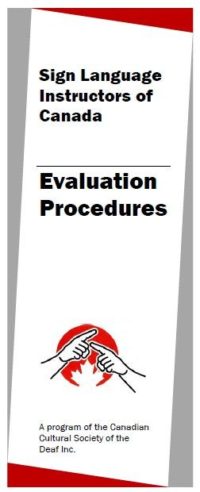 |
ASLICE Application RequirementsPlease read carefully The candidate shall: a) Be an active member of a provincial cultural society of the Deaf (if there is no cultural society in your province, an active member of a provincial organization of the Deaf) b) have taught ASL to student for a minimum of 400 hours of documented instruction within a three year period. c) Consider ASL his/her first language and have proficiency in ASL; rated at ASLPI of 4 or above. d) Have a letter of reference from an executive of a provincial cultural society of the Deaf and one letter vouching for his/her good standing from an administrator in a recognized program* where s/he has worked . e) Have attended/taken ASL or ASL-related workshops and courses** in a recognized program or under the direction of a recognized organization of the Deaf in the past 5 years. * A recognized program is defined as follows: A recognized program of ASL instruction is one that is affiliated with a public or private agency, an educational institution or a continuing education program which has a supervisor or coordinator for ASL courses. * Related courses are those pertaining to ASL, language teaching principles, Deaf culture, Deaf Studies and/or heritage, classroom management, teaching strategies, lesson planning, adult education, or curriculum. |
Five Steps to Certification
Step 1: Initial Application
The potential Candidates send their resume or CV by email to the attention of ASLICE at the DEAF CULTURE CENTRE, 15 Mill Street, Toronto Ontario M5A 3R5 by the last Friday of January along with a payment of $200.00. The application package must also contain letters from an organization of the Deaf and institutions, rerecord of teaching hours and workshops taken or presented. Applications arriving late will not be considered. If your application for evaluation is denied, we will refund you $200.00 minus a $50 for processing applications.
Step 2: Evaluation Manual
Upon being accepted for evaluation, candidates will be sent a candidate’s manual outlining the evaluation procedures at the beginning of March. We will give candidates at least 5 months to prepare before taking the on-line evaluation. ** You are required to submit certified proof of ASLPI rating before taking sub-test #1. (this is only temporary)**
Step 3: Testing
A) Sub-test #1: Structure of ASL (Multiple choice with video).If a candidate has failed the sub-test and wishes to re-take, there is an $80.00 charge.
B) Sub-test #2: General Knowledge—questions based on required reading and video viewings. If a candidate has failed the sub-test and wishes to re-take, there is an $80.00 charge
C) Sub-test #3: Interview– The interview is conducted through video-conferencing. The candidate will be interviewed by raters.
Should there be a dispute over Rater and Interviewer results, the final decision authority will be Julie Martin
Step 4: Certification
An ASLIC certificate will be sent to successful candidates. This document will certify that the candidate has met the requirements of SLICE and is qualified to teach ASL.
Step 5: Certification
Complete Required Readings
1. American Sign Language—A Teacher’s Resource Text on Curriculum, Methods, and Evaluation (by Dennis Cokely and Charlotte Baker-Shenk)
2. American Sign Language—A Teacher’s Resource Text on Grammar and Culture (Dennis Cokely and Charlotte Baker-Shenk)
3. Sign Naturally Units 1-6: Teacher’s Curriculum guide (by Cheri Smith, Ella Mae Lentz & Ken Mikos)
4. Sign Naturally Units 1-6: Student Workbook (by Cheri Smith, Ella Mae Lentz & Ken Mikos)
5. Sign Naturally Units 7-12 Teacher’s Curriculum guide (by Cheri Smith, Ella Mae Lentz & Ken Mikos)
6. Sign Naturally Units 7-12 Student Workbook (by Cheri Smith, Ella Mae Lentz & Ken Mikos)
7. Master ASL! Level 1 ( by Jason e. Zinza)
8. Learning to See: Teaching ASL a Second Language (by Sherman Wilcox)
9. Linguistics of ASL: An Introduction (by Clayton Vallli, Ceil Lucas, Kristin Mulrooney, & Miako Villanueva)
10.Introduction to American Deaf Culture (by Thomas Holcomb)
11.Deaf Heritage in Canada: A distinctive, diverse, and
Enduring Culture (by Clifton F. Carbin)
Complete Required Viewing (DVDs)
1.American Sign Language—A Teacher’s Resource Text on Curriculum, Methods, and Evaluation (by Dennis Cokely and Charlotte Baker-Shenk)
2. Introduction to American Deaf Culture ( by MJ Bienvenu and Betty Colonomos) Five Series
3. Signing Naturally Units 1-6: Teacher’s Curriculum Guide (by Cheri Smith, Ella Mae Lentz & Ken Mikos)
4. Signing Naturally Units 1-6: Student Workbook (by Cheri Smith, Ella Mae Lentz & Ken Mikos)
5. Signing Naturally Units 7-12: Teacher’s Curriculum Guide (by Cheri Smith, Ella Mae Lentz & Ken Mikos)
6. Signing Naturally Units 7-12: Student Workbook (by Cheri Smith, Ella Mae Lentz & Ken Mikos)
7. Linguistics of American Sign Language—5th Edition (by Clayton Valli, Ceil Lucas, Kirstin Mulroney & Miako Villanueva)
8. See What I mean: Differences between Deaf and Hearing Cultures (by Thomas K. Holcomb & Anna Mindess)
9. The Heart of Deaf Culture (by Rochester Institute of Technology)


